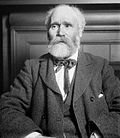Emmeline Pankhurst
Emmeline Pankhurst (née Goulden; 15 July 1858 – 14 June 1928) was the leader of the British suffragette movement which helped women win the right to vote.
Emmeline Pankhurst | |
|---|---|
 Emmeline Pankhurst (c. 1913) | |
| Personal details | |
| Born | 15 July 1858 Moss Side, Manchester, England |
| Died | 14 June 1928 (aged 69) Hampstead, London, England |
| Political party | Women's Party (1917–1919) Conservative Party (1926–1928) |
In 1999 Time named Pankhurst as one of the 100 Most Important People of the 20th Century, stating: "she shaped an idea of women for our time; she shook society into a new pattern from which there could be no going back."[1] She was widely criticized for her militant tactics, but her work helped to achieve women's suffrage in Britain.[2][3]
After her husband died in 1898, Pankhurst founded the Women's Social and Political Union (WSPU), an organisation dedicated to "deeds, not words".[4] The group became infamous when its members smashed windows and assaulted police officers. Pankhurst, her daughters, and other WSPU activists were sentenced to repeated prison sentences, where they staged hunger strikes to secure better conditions. As Pankhurst's oldest daughter Christabel took the helm of the WSPU, antagonism between the group and the government grew. Eventually arson became a common tactic among WSPU members, and more moderate organisations spoke out against the Pankhurst family. In 1913 several prominent individuals left the WSPU, among them Pankhurst's daughters Adela and Sylvia. The family rift never healed.
With the advent of the First World War, Emmeline and Christabel called an immediate halt to militant suffrage activism in support of the British Government's stand against the "German Peril".[5] They urged women to aid industrial production and encouraged young men to fight. In 1918 the Representation of the People Act granted votes to women over the age of 30 and the WSPU was disbanded.[6]
Pankhurst transformed the WSPU machinery into the Women's Party, dedicated to promoting women's equality in public life. In her later years she became concerned with the 'Bolshevik menace' and – unhappy with the political alternatives – joined the Conservative Party. She died in 1928, 17 days before women got equal voting rights[7] and was commemorated two years later with a statue in London's Victoria Tower Gardens.
Emmeline Pankhurst Media
Lydia Becker was an early influence on Pankhurst and may have been enamoured of Pankhurst's father
Richard Pankhurst first caught Goulden's eye when she spied his "beautiful hand" opening the door of a taxi as he arrived at a public meeting in 1878
Harriot Eaton Stanton Blatch, daughter of US suffragist Elizabeth Cady Stanton, became friends with Pankhurst through their work in the Women's Franchise League.
Keir Hardie worked with the Pankhursts on a variety of political issues and later became a very close friend of Sylvia's.
Christabel Pankhurst, often called the favourite child, spent almost 15 years working by her mother's side for women's suffrage.
The WSPU. It was founded at Pankhurst's home on 62 Nelson Street, Manchester in 1903. The Grade II* Victoria Villa is now home to the Pankhurst Centre.
References
- ↑ Warner, Marina (14 June 1999). Emmeline Pankhurst – Time 100 People of the Century. Time Magazine. http://www.time.com/time/magazine/article/0,9171,991250,00.html.
- ↑ Bartley, Paula. 2002. Emmeline Pankhurst. London: Routledge. ISBN 0-415-20651-0
- ↑ Fulford, Roger. 1957. Votes for Women: the story of a struggle. London: Faber & Faber.
- ↑ Pankhurst, Emmeline. 1914. My own story. London: Virago Limited, 1979, p38. ISBN 0-86068-057-6
- ↑ Purvis, June. 2002. Emmeline Pankhurst: a biography. London: Routledge, p270. ISBN 0-415-23978-8
- ↑ "Start of the suffragette movement". UK Parliament. Retrieved 2018-03-13.
- ↑ "Emmeline Pankhurst". Biography. Retrieved 2018-03-13.
Other websites
 Media related to Emmeline Pankhurst at Wikimedia Commons
Media related to Emmeline Pankhurst at Wikimedia Commons Works written by or about Emmeline Pankhurst at Wikisource
Works written by or about Emmeline Pankhurst at Wikisource Quotations related to Emmeline Pankhurst at Wikiquote
Quotations related to Emmeline Pankhurst at Wikiquote








